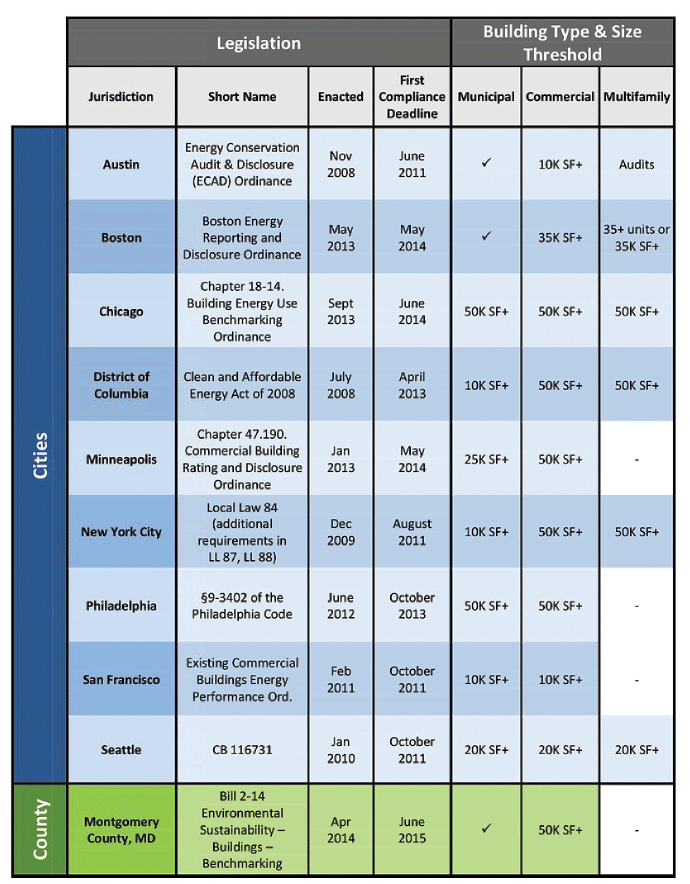Understanding Energy Benchmarking Ordinances
Energy benchmarking is already required in 10 cities, one county, and two states. The cities include Austin, Boston, Cambridge, Chicago, Washington, D.C., Minneapolis, New York, Philadelphia, San Francisco, and Seattle. The county is Montgomery County, Md., and the states are California and Washington. These energy benchmarking ordinances generally cover buildings over 50,000 square feet, which encompasses almost 6 billion square feet of real estate.
The ordinances for each jurisdiction are similar, but they do have different requirements. The following are some of the requirements:
- Benchmarking for different sizes and types of buildings (10,000 square feet, 50,000 square feet, etc.), municipal, commercial, multifamily.
- Some require annual public disclosures — most on a public website. In general, disclosure is not required the first year of benchmarking, allowing building owners to improve their scores before the data is disclosed to the public.
- Some only require disclosures at point of transaction to buyers, tenants, lenders.
- Staggered requirements — requirements that the biggest buildings comply first, high rise residential buildings last.
- Penalties — each jurisdiction has a different system; some have no penalties.
- Some require water use tracking.
- Some require energy audits or retrocommissioning.
- Some require verification by a licensed professional.
- All require use of Energy Star Portfolio Manager.
For more on each ordinance, visit www.buildingrating.org.
The first step to energy benchmarking is signing up for Energy Star Portfolio Manager. Next is collecting utility bills, setting up a profile in Portfolio Manager, and inputting the data into the online software. In some locations, such as Chicago, the data must be verified by a qualified professional. It is then turned over to the local jurisdiction, usually electronically.
The types of information required for the profile include the local jurisdiction benchmarking ID, property details, gross floor area, property use types, gross floor area per use type, and use details. Data needed for benchmarking is generally whole-building aggregated data (including base building and tenants). Each meter must be included. In some locations, such as Chicago, the local utility company will help with obtaining the aggregated data, including tenant data. Where local utility assistance in obtaining tenant data is not provided, this is likely to be the most difficult aspect of energy benchmarking. Buildings that already have an Energy Star score are ahead of the game and can usually use the data that has been submitted to obtain that score.
In addition to being a tool to input data for one building or an entire portfolio of buildings, Portfolio Manager calculates various metrics that help facility managers better understand their energy use and how it compares to others. It also provides key performance metrics that can be integrated into a strategic management plan. The metrics include:
- EUI — Energy Utilization Index (source, site, and weather normalized). EUI equals total BTUs/square foot/year and is based on source energy not site energy.
- Greenhouse gas emissions (indirect, direct, total, avoided).
- Energy Star score (1 to 100), available for many building types.
Comparison of 10 U.S. Municipal Building Energy Benchmarking and Disclosure Policies

Related Topics:
















